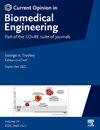Vascularization of organoid microenvironments: Perfusable networks for organoid growth and maturation
IF 4.2
3区 工程技术
Q2 ENGINEERING, BIOMEDICAL
引用次数: 0
Abstract
Generation of functional vasculature within organoids is considered important for their development and maturation. However, direct differentiation of endothelial cells (ECs) in organoids remains challenging so that creating fully perfusable vasculature often still requires transplantation into host animals. This review discusses recent strategies for generating pre-vascularized human pluripotent stem cell (hPSC)-derived organoids, that include co-differentiation of ECs using growth factors or (an inducible transcription factor) ETV2, controlled assembly of tissue organoids with hPSC-derived ECs or Blood Vessel Organoids (BVOs), and 3D bioprinting. Additionally, the potential and key challenges of organ-on-chip technology for creating perfusable and functional vascular networks in organoids are explored, highlighting their implications for advancing research and improving experimental models of human tissue and disease.
类器官微环境的血管化:类器官生长和成熟的可灌注网络
类器官内功能血管的生成被认为对它们的发育和成熟很重要。然而,在类器官中直接分化内皮细胞(ECs)仍然具有挑战性,因此创建完全可灌注的血管系统通常仍然需要移植到宿主动物中。这篇综述讨论了最近用于生成预血管化人类多能干细胞(hPSC)衍生类器官的策略,包括使用生长因子或(一种诱导转录因子)ETV2对ECs进行共分化,用hPSC衍生的ECs或血管类器官(BVOs)控制组织类器官的组装,以及生物3D打印。此外,探讨了器官芯片技术在类器官中创建可灌注和功能性血管网络的潜力和关键挑战,强调了它们对推进研究和改进人体组织和疾病实验模型的意义。
本文章由计算机程序翻译,如有差异,请以英文原文为准。
求助全文
约1分钟内获得全文
求助全文
来源期刊

Current Opinion in Biomedical Engineering
Medicine-Medicine (miscellaneous)
CiteScore
8.60
自引率
2.60%
发文量
59
 求助内容:
求助内容: 应助结果提醒方式:
应助结果提醒方式:


